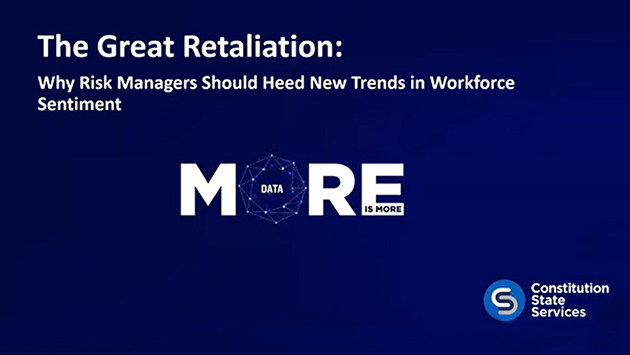What Is Driving Higher Employee Resignations?


Attitudes about the employer/employee relationship are shifting and changing the nature of workforce risk driving current trends toward more employee resignations and even retaliation in the post-pandemic workplace. Constitution State Services (CSS) – in partnership with RIMS – moderated a discussion with three industry thought leaders and experts on the subject: Dr. Anthony Klotz, Associate Professor of Organizational Behavior at UCL School of Management in London; Keith Andersen, Vice President, General Liability at CSS; and Robert Kreuzer, SVP, Risk Control at CSS. Each offered valuable insights into which industries are likely to experience above average quit rates, why proactive team management is critical to boosting morale and retention, and what you can do to get ahead of emerging risks and protect your company in an era of unprecedented organizational change.
Here are some of the pointed observations and practical strategies they shared to help businesses navigate the ever-evolving landscape of modern workforce risk.
- Resignation rates, which hit an all-time high in 2019, continued to rise steadily amid shifting employer/employee dynamics. According to Dr. Klotz, resignation rates have increased every month since 2021, at times reaching levels 25% higher than 2019’s previous record. Today, they’re currently hovering around 20%, a plateau Dr. Klotz attributes to companies’ willingness and ability to react quickly. “Employers haven’t just sat alongside doing nothing,” he said. “You’ve seen over the past few years organizations making bigger investments in employee compensation, benefits, flexibility, family-friendly work policies … and I think that’s really paid dividends in terms of getting these resignation numbers under control.” But there’s still tension as power appears to be shifting back to employers and unemployment numbers may begin creeping back up. “A lot of companies are saying, ‘Can’t we get back to normal, to the way things were?’ And workers are saying, ‘Can’t we get to normal in terms of a new normal, the future?’”1
Dr. Klotz studies not just why but how employees quit their jobs. While the world was eager to get back to normal once vaccines became available and the economy appeared to be on an upswing, he was cautiously following the four trends he believes gave the Great Resignation – the phenomenon that he was first to predict in 2020 – its momentum:
Resignation backlog
“A lot of individuals were waiting to enact their plans to switch careers, to switch jobs, and that would create a lot of tightness in the labor markets that would fuel more resignations.”
Employee burnout
“It wasn’t limited necessarily to frontline workers… we were also seeing high levels of stress in the executive suite, among middle managers, among workers who were trying to educate their kids from home, while having a full-time job.”
Pandemic epiphanies
“We had millions of individuals reflecting on their lives and saying, is my life on the right path? And when we ask that question, we often look at how much satisfaction, how much meaning am I getting from my job.”
Remote work
"When you give individuals increased autonomy for a year or two and then you ask them to give that autonomy back, it often doesn't go well, and it leads to higher resignations."

Dr. Anthony Klotz
Associate Professor of Organizational Behavior at UCL School of Management in London
- “Quiet quitting” is on the rise as the threat of recession looms. Recessions and rising unemployment rates tend to go hand in hand, depressing the resignation rate as bleaker labor markets deter employees from quitting.1 But Dr. Klotz cautions employers with hopes that a recession will end the era of the Great Resignation. “Right now employees want their organizations to embrace new ways of working, to invest more in them, to do more. The drivers don’t go away… a recession just means they’re less likely to quit their jobs over that,” he warned. Instead, we see dissatisfied workers “quietly quitting,” having an impact that’s just as devastating as mass resignation. “Quiet quitting is quitting going above and beyond our job description,” Dr. Klotz explained. “It means not arriving early, not pulling an all-nighter, not attending those non-mandatory meetings. It may mean I’m not going to speak up when I see a safety issue. And that can be really harmful to an organization.”
- While resignation rates for the frontline retail, restaurant and healthcare workers who got us through the pandemic are stabilizing, other industries – like professional services and transportation – are showing recent spikes.1 “It’s important to think within industries, too,” said Dr. Klotz. “I’m often struck by how different turnover rates are between companies within the same industry, and a lot of it comes down to are organizations using this time to invest in workers, in trying to make that future of work a reality, trying to experiment with new ways of working that will lead to higher employee well-being, or are they playing the wait-and-see game hoping that we return to the old ways of working?”
- Organizations have begun taking away benefits extended to employees during the pandemic, like remote working and family-friendly policies, ushering in a new era of workforce risk that Dr. Klotz calls “The Great Retaliation.1 “It’s perfectly fine to roll back benefits if it’s really a business necessity, but that needs to be clearly communicated to employees,” he said. “We’re seeing benefits, compensation and flexible working being rolled back without a whole lot of explanation, and that’s a recipe for disaster.” As an example, Dr. Klotz noted one study showing that workers equate the ability to work remotely to a 6% pay raise, so taking that benefit away becomes perceived as a pay decrease.1

“On a latent defect or something that was manufactured incorrectly or didn’t meet the specs of the product that was supposed to be part of a bigger product … we don’t see claims arise out of the bad products until, on average, four years after they’re constructed. So we go back and as we investigate and try to understand what happened, a lot of it, if not most of it, is quality control-related. We can, in many cases, pinpoint exactly what happened, at what point on the assembly line or what person in a construction setting actually caused this. Some of it has to go with the disengaged employee that just didn’t care, somebody that was in over their head, trying to do a good job, but they just didn’t or they weren’t properly trained. Nobody intended any of this. It’s just what happened … so help your employees make sure that they understand their role – and it’s not just the training, but it’s to come in and check, monitor and make sure that they are executing the way you need them to execute.”
Keith Andersen on the Importance of Quality Control
Vice President of General Liability at Constitution State Services
- In today’s tight labor market, staffing agencies are exercising greater bargaining power to contractually shift general liability exposure to employers scrambling to fill positions – a risk exacerbated by the rise of nuclear verdicts. Temp workers, no matter how experienced, are essentially new employees who are statistically more likely to become injured their first year on the job. “As the one bringing the employee into your organization, you are now open for a liability exposure that would, under normal circumstances, simply be a workers comp exposure,” noted Keith Andersen, VP of General Liability at CSS. “And the playing field has changed. Companies are held to a high, high standard. The plaintiff bar understands societal changes and shifts, and they’re exploiting that. It’s not about making that person whole, it’s about generating generational wealth, and juries are not appreciating the value of that money, or where that money comes from.”

“The best way to not have to contend with a construction defect, claim, workers comp injury or even social inflation – because once those things get in the system, it’s really hard to navigate – is to not get there … so there’s some key things, lots of traditional things that folks on the line do every day, and I think it’s a bit of doubling down on some of that, and also thinking differently. You know how important onboarding is. Also making sure that whatever you have from a safety and operational procedure standpoint is shared and shared often. Skill development and, from a recruiting and pipeline perspective … you can look for talent, whether it’s some of the traditional pools that you’re all fishing in versus trying to look differently at the skills you need, what skills you have and how you bridge that gap – you might be able to look in some different places. And one thing I’m big on is trying to create a culture of candor between the corporate office and shop floor. Having that two-way communication is so important, transparent communication creating an environment of engaged employees.”
Robert Kreuzer on Creating a Corporate Culture of Safety
Senior Vice President, Risk Control at Constitution State Services
- Open communication is key to keeping your workplace safe and workforce satisfied. According to Robert Kreuzer, Senior Vice President of Risk Control at CSS, consistent, transparent communication within an organization goes a long way toward keeping employees able and motivated to show up and do their best work. “It’s an ongoing repetitive strategy. Talk to different groups. Hear from folks around. Call them listening sessions,” he recommended. “What’s working well and, even more importantly, what do they see as challenges or obstacles? Establish an environment where you’ll hear things a lot sooner and can react quicker to put some things in place from a preventative standpoint. You can’t solve it today, but at least you can understand what that obstacle is and communicate how you’re trying to address it.”
To learn more about how we can help optimize your claim outcomes, contact the CSS representative in your region.
Sources
1 RIMS.org: The Great Retaliation: Why Risk Managers Should Heed New Trends in Workforce Sentiment







